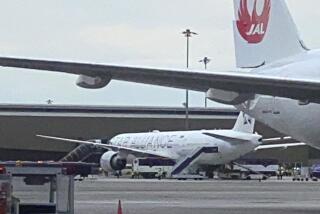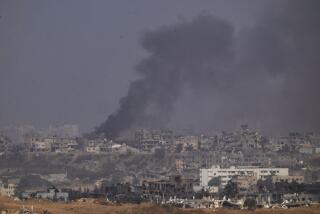Perilous Nuclear Tunnel Vision
Deep beneath Iraqi soil, armored bunkers protect Saddam Hussein’s arsenal of chemical and biological weapons. As the Bush administration lays plans for taking Baghdad, these bunkers are much on the minds of military planners.
The problem has brought back to life the idea of tactical nuclear weapons on the battlefield. Powerful administration proponents often characterize their position as choosing a lesser evil: Either develop the nuclear bunker killers or let Hussein and his cronies hide safely underground with their weapons. Unfortunately, this tunnel vision downplays both the consequences of nuclear weapons on the battlefield and the impressive potential of U.S. nonnuclear forces against hardened bunkers.
During the Cold War, the primary deep-buried targets were Soviet missile silos. The choice was easy: Detonate nuclear-tipped ballistic missiles above a silo and destroy it. In the context of a full-scale nuclear war, this strategy made perverse sense. There would be no friendly ground troops to endanger, no complex war strategy to disrupt. Thankfully, this scenario is now implausible.
The wars in Afghanistan and Kosovo are the models for future conflicts: tightly coordinated, maneuverable Special Forces units working with local resistance and coordinating precise airstrikes. A massive bunker-busting nuclear weapon does not fit this strategy.
Using nuclear weapons to destroy buried targets would irradiate battlefields for friendly and enemy troops alike. A strike even within several miles of a town or city would cause mass civilian casualties. This would be true even if, as some supporters have suggested, the weapon was a low-yield earth penetrator far smaller than the bomb used on Hiroshima.
Fortunately, there is a better way. Command and control bunkers can be effectively rendered useless by strikes against their vulnerable above-ground communications stations. Entrances to buried facilities can be sealed using precision weapons, including incendiaries and thermobaric vacuum bombs that kill the occupants.
Advanced penetrating missile technology can also be used to directly attack buried targets. Consider the BLU-116, a 2,000-pound penetrating weapon already in the U.S. arsenal. A new “smart fuse” is being developed to allow the warhead to detonate at a very precise depth, increasing its effectiveness against buried targets.
These conventional weapons are also better penetrators than their nuclear counterparts. Such a weapon experiences massive shock as it slams into the earth; the warhead it carries has to endure that traumatic impact. Nuclear weapons are exquisitely sensitive items, making the engineering of nuclear earth-penetrators significantly more difficult than that of conventional penetrators.
Other, more futuristic solutions are in the works. The military is exploring a system known as Deep Digger, which would look like a conventional missile but operate on principles of dry drilling used in oil exploration. It would use a rapid-fire cannon to quickly hammer a hole deep into the ground. The digging projectiles fired by the cannon would be filled with a high-density gas so that pulverized rock would be cleared away by the rising gas. A smart fuse would detonate the payload once Deep Digger reached its target. All of this is designed to weigh only 100 to 200 pounds, so it could be carried by Special Forces units or launched from an aircraft. Even more novel weapons could include foam that would harden inside a bunker.
It is simply not necessary to choose the lesser of two evils in handling the bunker threat. Nuclear weapons can remain the option of last resort, not routine battlefield tools that, once deployed, could lower the bar to the use of nuclear weapons against the U.S. and its allies.
*
Michael Levi directs the strategic security program at the Federation of American Scientists. Theresa Hitchens is vice president of the Center for Defense Information.
More to Read
Start your day right
Sign up for Essential California for news, features and recommendations from the L.A. Times and beyond in your inbox six days a week.
You may occasionally receive promotional content from the Los Angeles Times.






